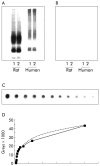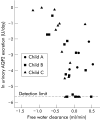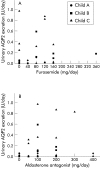Increased urinary excretion of aquaporin 2 in patients with liver cirrhosis
- PMID: 12865281
- PMCID: PMC1773760
- DOI: 10.1136/gut.52.8.1194
Increased urinary excretion of aquaporin 2 in patients with liver cirrhosis
Abstract
Background and aim: Water retention is a major clinical problem in patients with liver cirrhosis. Recent research suggests that renal aquaporins may be pathophysiologically involved in this condition. The aim of the present cross sectional study of patients with liver cirrhosis was to determine if 24 hour urinary excretion of renal aquaporin 2 (AQP2) differed from that of healthy control subjects and if such excretion was related to the severity of liver disease and to the patient's water balance.
Results: Twenty four hour urinary excretion of AQP2 and free water clearance were measured in 33 stable cirrhosis patients on usual medication and in eight healthy subjects. AQP2 excretion, quantitated by immunoblotting, was eight times higher in cirrhosis patients than in controls (0.167 (0.270) U/day v 0.021 (0.017); p<0.05). Stratification according to clinical manifestations (Child- Pugh classes) revealed that it increased with the clinical severity of cirrhosis (class A 0.04 (0.04); class B 0.09 (0.16); class C 0.31 (0.35); p<0.05) but was not related to liver function, as measured by galactose elimination capacity. Excretion correlated inversely with free water clearance (rho=-0.57, p<0.01). It was higher in patients with oesophagogastric varices but not in those with ascites. Plasma vasopressin concentrations were not related to AQP2 excretion and there was no relation to dose or type of diuretic treatment.
Conclusions: Urinary AQP2 excretion was increased in patients with cirrhosis. Moreover, urinary AQP2 excretion increased with severity of cirrhosis in parallel with impairment of free water clearance. This suggests a functional association between increased AQP2 excretion and increased renal reabsorption of water in cirrhosis.
Figures




Similar articles
-
Urinary aquaporin-2 in healthy humans and patients with liver cirrhosis and chronic heart failure during baseline conditions and after acute water load.Kidney Int. 2003 Apr;63(4):1417-25. doi: 10.1046/j.1523-1755.2003.00858.x. Kidney Int. 2003. PMID: 12631357
-
Urinary excretion of the water channel aquaporin 2 correlated with the pharmacological effect of tolvaptan in cirrhotic patients with ascites.J Gastroenterol. 2016 Jun;51(6):620-7. doi: 10.1007/s00535-015-1143-3. Epub 2015 Nov 26. J Gastroenterol. 2016. PMID: 26610908
-
Water immersion increases urinary excretion of aquaporin-2 in healthy humans.Nephron. 2000 May;85(1):20-6. doi: 10.1159/000045625. Nephron. 2000. PMID: 10773751
-
Urinary excretion of aquaporin-2 in pathological states of water metabolism.Ann Med. 2000 Mar;32(2):90-3. doi: 10.3109/07853890009011757. Ann Med. 2000. PMID: 10766399 Review.
-
Vasopressin release, water channels, and vasopressin antagonism in cardiac failure, cirrhosis, and pregnancy.Proc Assoc Am Physicians. 1998 Sep-Oct;110(5):407-11. Proc Assoc Am Physicians. 1998. PMID: 9756091 Review.
Cited by
-
Predictive Value of Urinary Aquaporin 2 for Acute Kidney Injury in Patients with Acute Decompensated Heart Failure.Biomedicines. 2022 Mar 6;10(3):613. doi: 10.3390/biomedicines10030613. Biomedicines. 2022. PMID: 35327416 Free PMC article.
-
Aquaporin-2 urinary excretion in cirrhosis: relationship to vasopressin and nitric oxide.Dig Dis Sci. 2010 Apr;55(4):1135-41. doi: 10.1007/s10620-009-0829-x. Epub 2009 Jun 3. Dig Dis Sci. 2010. PMID: 19495975
-
Vasopressin and aquaporin 2 in clinical disorders of water homeostasis.Semin Nephrol. 2008 May;28(3):289-96. doi: 10.1016/j.semnephrol.2008.03.009. Semin Nephrol. 2008. PMID: 18519089 Free PMC article. Review.
-
Renal dysfunction in cirrhosis.Curr Opin Gastroenterol. 2015 May;31(3):215-23. doi: 10.1097/MOG.0000000000000168. Curr Opin Gastroenterol. 2015. PMID: 25763790 Free PMC article. Review.
-
Urinary Aquaporin 2 as a Potential Indicator Predicting Tolvaptan Response in Patients With ADPKD.Kidney Int Rep. 2021 Jul 14;6(9):2436-2444. doi: 10.1016/j.ekir.2021.06.033. eCollection 2021 Sep. Kidney Int Rep. 2021. PMID: 34514204 Free PMC article.
References
-
- Gines P, Berl T, Bernardi M, et al. Hyponatremia in cirrhosis: from pathogenesis to treatment. Hepatology 1998;28:851–64. - PubMed
-
- Nielsen S, Frokiaer J, Marples D, et al. Aquaporins in the kidney: from molecules to medicine. Physiol Rev 2002;82:205–44. - PubMed
-
- Kanno K, Sasaki S, Hirata Y, et al. Urinary excretion of aquaporin-2 in patients with diabetes insipidus. N Engl J Med 1995;332:1540–5. - PubMed
-
- Elliot S, Goldsmith P, Knepper M, et al. Urinary excretion of aquaporin-2 in humans: A potential marker of collecting duct responsiveness to vasopressin. J Am Soc Nephrol 1996;7:403–9. - PubMed
Publication types
MeSH terms
Substances
LinkOut - more resources
Full Text Sources
Medical
